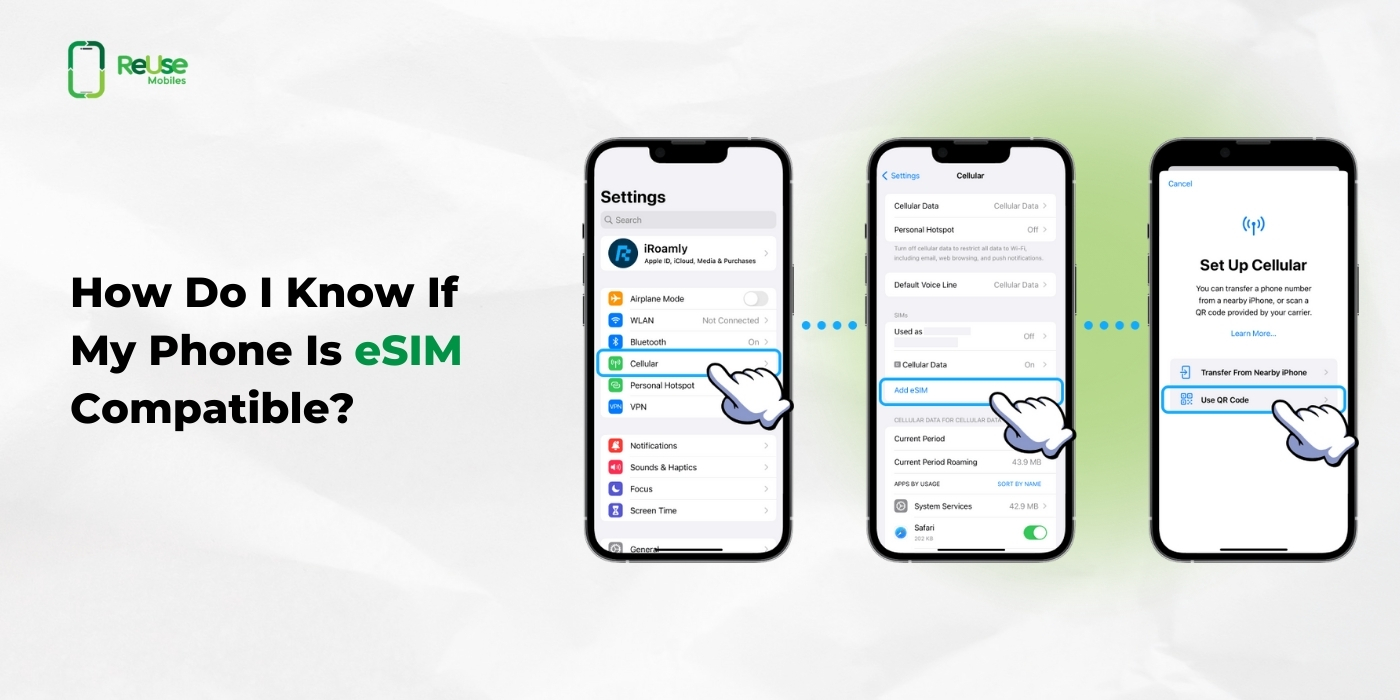
With the rise of digital technology, eSIM (Embedded SIM) technology is becoming increasingly popular. Unlike traditional SIM cards, eSIMs offer flexibility. They allow users to store multiple profiles on a single device without needing a physical SIM card.
We’ve all faced the inconvenience of searching for a SIM card pin, only to come up empty-handed. With eSIMs, that frustration is a thing of the past. Short for “embedded SIM,” eSIM removes the need for a physical SIM card. The digital card is embedded directly into your phone’s hardware. With them, you can switch between multiple profiles and enjoy hassle-free services without handling or replacing physical SIM cards. Are you wondering ‘Is my phone eSIM compatible’? This blog will help you. We’ll explore eSIM technology and how to check if your device supports it.
Is your phone eSIM ready?
Now, You might be asking yourself, ‘How do I know if my phone is eSIM compatible?’ To determine if your phone is compatible, you need to check both the hardware and software specifications. Most smartphones released since 2018 are likely to support eSIM technology, but this can vary by manufacturer and model.
The good news is more and more modern smartphones are adopting this feature. Here are some of the popular brands supporting this tech:
Apple
eSIM compatibility is available on a range of iPhones, including the latest iPhone 15 series, as well as earlier models like the iPhone 12, iPhone 13, and iPhone SE.
Samsung
This brand also produces eSIM-compatible phones, including devices under the Galaxy S, Note, Z, and A series.
Google
Pixel phones have supported eSIM since the Pixel 3. Advanced models like the Pixel 7 and the foldable Pixel Fold further enhance the user experience by offering seamless eSIM management.
Other Brands
eSIM technology is expanding across various brands, including:
Huawei
Devices like the Mate 40 Pro feature eSIM.
OPPO
Models such as the Find X5 Pro support this technology.
Nokia
Phones like the XR21 also include eSIM functionality.
Check Your Model and Region
While many phones are eSIM-compatible, certain factors can affect functionality:
Regional limitations
Some models sold in markets like the US or Japan might lack eSIM support due to carrier-specific restrictions.
Carrier settings
Verify with your service provider to ensure eSIM is enabled on your device.
Unlocked status
Locked devices might restrict eSIM use, so confirm your phone is unlocked if switching carriers is your goal.
How to Check If My Phone is eSIM Compatible?
The thought might cross your mind, ‘Is my phone compatible with eSIM’? To check if your phone is compatible, follow these steps based on your device type:
For iPhone Users
Go To ‘Settings’
Open Settings on your iPhone and select the ‘General’ section.
Open ‘About’
Tap on About and look for the “Carrier Lock” or “Network Provider Lock” entry. If it says ‘No SIM restrictions’, your device is likely unlocked and ready for eSIM.
Check IMEI
Scroll further down to check for an IMEI (eSIM) entry. If you find it, your iPhone supports eSIM.
For Android Phones
The process for Android devices can vary slightly depending on the brand, but here’s a general guide:
For Google Pixel Phones
Settings
Navigate to Settings and then open ‘Network & Internet’. Under it, you will find Mobile Network.
Check for the Option
If you find the tab ‘Add carrier’ or ‘Add eSIM’, the phone is compatible with eSIM tech.
For other Android devices, go to Network or SIM settings and look for an option mentioning eSIM.
For Samsung Users
If you are a Samsung phone owner and wondering ‘Does my phone support eSIM’, the good news is – it does. Most Samsung Galaxy phones like Galaxy Note 20 and Galaxy S20 series support eSIM tech. However, eSIM availability can vary significantly depending on the region where the phone was purchased and the specific carrier. To check your phone’s compatibility:
Open Settings
Go to the Connections Menu
Select SIM card manager
Check for an option to add or manage eSIM
General Tips
Here are some other ways, you can confirm
Manufacturer’s Website
Search for your device model on the official website and check its technical specifications for eSIM support.
User Manual
The manual that comes with your phone usually includes information about its features, including eSIM compatibility.
Customer Support
If in doubt, reach out to your phone’s manufacturer or your mobile carrier for help.
 Skip to content
Skip to content









